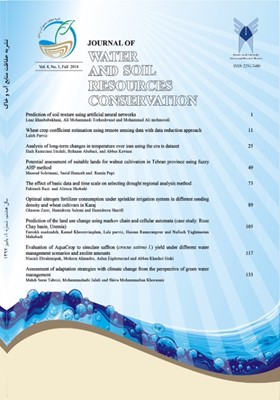Prediction of the land use change using markov chain and cellular automata (case study: Roze Chay basin, Uremia)
Subject Areas : Farm water management with the aim of improving irrigation management indicatorsFarrokh Asadzadeh 1 * , Kamal Khosravi Aqdam 2 , Laleh Parviz 3 , Hassan Ramazanpour 4 , Nafiseh Yaghmaeian Mahabadi 5
1 - Assistant Professor, Department of Soil Science, Urmia University, Urmia, Iran
2 - Ph.D. student, Department of Soil Science, University of Guilan
3 - Faculty of Agriculture, Azarbaijan Shahid Madani University, Tabriz, Iran
4 - Associate Professor, Department of Soil Science, University of Guilan
5 - Assistant Professor, Department of Soil Science, University of Guilan
Keywords: Markovin transmission estimator, Landsat, Land use modeling, Maximum Likelihood,
Abstract :
Land use surveys and investigations are a prerequisite for the study of watersheds, because regional planning is dependent on the awareness about land use type and future changes. As a result, modeling and predicting of land use is essential for land planning and management in the future of a country such as Iran, where land use is changing rapidly In this regard, in order to reveal the land use changes in the 15 years and modeling the changes for the next 20 years, the markovin transmission estimator was used with Landsat 7 and 8 Landsat satellite imagery data from the Roze Chay basin of urmia. Based on the controlled classification algorithm with the maximum probability of land use as seven classes of land uses in this watershed were seven garden, irrigated farming, dry farming, grass land, residential area, water and salt marsh with a mean Kappa coefficient of 0.88 and overall accuracy of 0.9 for 2000 and 2015 were extracted. The changes of 15 years showed that the variation of water dependent uses in the region decreased during the mentioned time period (percentage reduction in the area of agricultural crops and gardens, 32.51). The modeling of land use changes in the region with the markovin transmission estimator suggests that the use of gardens, arable and dry lands, villages and water resources will decrease, and the use of grass land and salt marsh will increase in the region (from 2020 to 2035 percent increase in area grass land 13.11 and the percentage of dry farming 17.56). The results indicate that soil and water resources are used improperly in the studied area, which requires comprehensive planning and management in the watershed.
_||_

